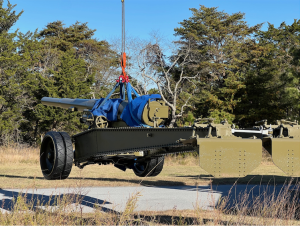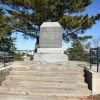Restored coast artillery gun installed at Fort Miles museum
The Fort Miles Historical Association recently announced the return of a historic 155mm GPF coast artillery gun to Cape Henlopen State Park in early November after an absence of 81 years. This World War I-era artillery holds significant relevance to Fort Miles’ wartime legacy.
A battery of four 155mm Grande Puissance Filloux guns made up the first Army coastal defenses to be placed at the cape in 1941 at the start of World War II. After many years of searching, the FMHA and CHSP have placed a similar gun on public display in the Fort Miles Museum artillery park.
The original guns were moved from Fort DuPont, Delaware City to Cape Henlopen via the Pennsylvania Railroad in April 1941. The first practice firing was held May 10, 1941. In January 1942, the four 155s were placed on concrete-and-steel Panama mounts near what is now the CHSP bathhouse and designated as Battery 22. Those guns were withdrawn from the harbor defenses in May 1944 when permanent coast artillery replaced them. With the installation of the newly restored 155mm GPF, the FMHA completes its full collection of historic coast artillery, marking a milestone in the ongoing effort to preserve and interpret Delaware’s coastal and military history.
Through the efforts of FMHA member Terry McGovern, the rare 155mm GPF was located and acquired through an exchange with American Legion Post 566 in Akron, Ohio. CHSP provided a Vietnam-era 155mm M114 howitzer in return for the historically accurate GPF gun, which was transported in March from Ohio to New Jersey by The Mahan Collection Foundation, based in Basking Ridge, N.J. Mahan conducted a full professional restoration over a period of about eight months, returning the gun to historically accurate condition. After Mahan transported the restored gun to CHSP Nov. 13, Coastal Towing of Lewes lifted the gun from its trailer and placed it on the display pad in the museum’s artillery park.
“With this gun now in place, Fort Miles Museum can fully illustrate the origins of the fort’s World War II defensive capabilities,” said an FMHA spokesperson. “Completing the artillery park with this final GPF piece allows us to offer visitors a comprehensive and authentic interpretation of the fort’s role in protecting the East Coast during the war.”
Although there is no ceremony currently planned to mark the gun placement, the restored 155mm GPF is now available for public viewing every day near the entrance to the artillery park outside the Fort Miles Museum. Throughout the winter, the Fort Miles Museum, inside Battery 519, is open to the public from 10 a.m. to 4 p.m., every Friday and Saturday. Admission is free, and donations to the Fort Miles Historical Association are encouraged to support future preservation efforts.






















































